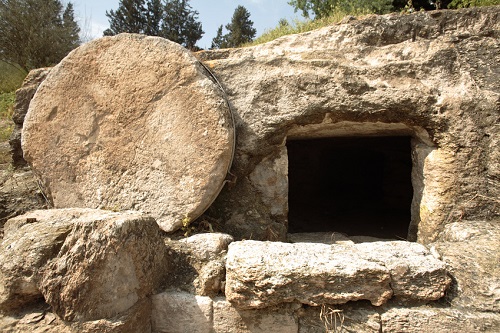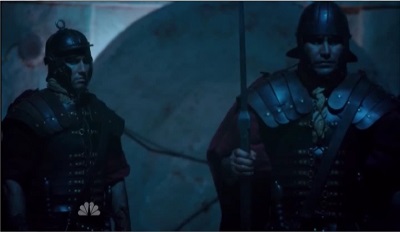|
Summary |
||
| In their article “Is the Shroud of Turin Authentic – or Is it a Forgery” Creation Ministries International (CMI) supports the theory that the Shroud of Turin is not the authentic burial shroud of Christ – it is a medieval forgery. This article refutes that theory, along with the main reasons CMI gives for rejecting authenticity.
This article relies primarily on the testimony of Shroud of Turin Research Project (STRP) members and other expert testimony to demonstrate there is a wealth of evidence CMI apparently did not consider before drawing their conclusions. This article is intended to inform the reader of those evidences and make available the testimony of the STRP members and other expert witnesses so that readers may judge for themselves whether CMI has reached the correct conclusion. It is the position of this article that they did not. The reader is encouraged to click on the links to view the referenced testimonies. |
Category Archives: Resurrection
This Easter, Thank God For Thomas
A Resurrection Day Meditation
The Apostle Thomas has been under-appreciated and unfairly characterized as “doubting” – as we understand doubting. Rather than doubting, Thomas is better described as the ultimate realist. He doesn’t put on rose colored glasses and see an idealized world. He sees things as they are in the real world. As such he provides one of the best proofs of the resurrection recorded in the Bible. A good thing to realize as we celebrate resurrection day. Let me explain why. Continue Reading
If the resurrection is true, why doesn’t everyone believe?
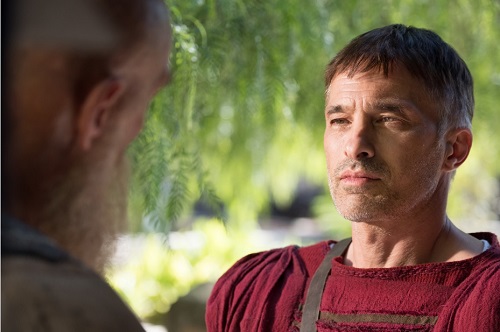
Prefect Mauritius Gallas speaks with the Apostle Paul in “Paul, Apostle of Christ”
A Meditation for Easter
Just-in-time for resurrection day (aka Easter), is the movie Paul, Apostle of Christ. In it, we find the apostle Paul (played by James Faulkner) in the jail of Roman prefect Mauritius Gallas (played by Olivier Martinez). As I mentioned in my review, this film presents the thinking Christian with many questions to ponder. One of those questions is about the resurrection and is posed by the prefect, which if memory serves, is actually phrased as a statement along these lines: If the resurrection were the truth, then all would believe. The movie has the apostle answering with a verse from his often quoted chapter on the resurrection (1 Cor 15.1-20):
“… if Christ has not been raised, our preaching is useless…” (1 Cor 15.14)
But that response answers the question, “is the resurrection true?” It does not really address the deeper issue the prefect appears to be getting at. That question is, Continue Reading
Detecting Design and Entropy on a Beach
We had the pleasure in vacationing in Jamaica this past summer. Of course we made it to the beach where I waded in and sat, enjoying the warm waters. As I looked around at the sand and rocks beneath the water I found a rock which appeared to have the impressions of a leaf embedded in it. With the possibility of having found a fossil I was, of course motivated to look for more. I found another one which appeared to have impressions of some type in it. I made a mental note to find someone knowledgeable about fossils to take a look at these to confirm whether these are what I thought they are.
As I continued to look for rocks in the warm water I came across an item I didn’t expect to find. It was perfectly square, about 1/8″ inch thick, flat on the bottom with beveled edges on top. It was blue with white speckles on top with a shiny coat covering the top, and solid white on the bottom. Continue Reading
Waiting for the End – A Meditation for Easter
.jpg)
Crucifixion of Jesus – Marco Palmezzano
“And at the ninth hour Jesus cried out in a loud voice, ‘Eloi, Eloi, lama sabachthani?’–which means, ‘My God, my God, why have you forsaken me?’ When some of those standing near heard this, they said, ‘Listen, he’s calling Elijah.’
One man ran, filled a sponge with wine vinegar, put it on a stick, and offered it to Jesus to drink. ‘Now leave him alone. Let’s see if Elijah comes to take him down,’ he said.
With a loud cry, Jesus breathed his last.”
“It was Preparation Day (that is, the day before the Sabbath). So as evening approached, Joseph of Arimathea, a prominent member of the Council, who was himself waiting for the kingdom of God, went boldly to Pilate and asked for Jesus’ body.
Pilate was surprised to hear that he was already dead. Summoning the centurion, he asked him if Jesus had already died.” When he learned from the centurion that it was so, he gave the body to Joseph.
Mark 15.34-37; 42-45
Pilate was surprised to learn that Jesus had died so quickly. That was because Roman crucifixion was not merely an execution. It was a slow death by way of torture, filled with excruciating pain, designed by the Romans to extend the amount of time it actually took to die as long as possible. “Historically the process could take anywhere from 3-4 hours to 3-4 days. And there were reports of people living as long as 9 days on a cross.”[1] The Jewish leaders and Pilate were both expecting it to take days for Jesus to die as was typical. That’s why the Jewish leaders petitioned Pilate to have his legs broken (John 19.31). Because when hung on a cross for crucifixion, “Modern forensic research shows that a person whose hands are bound above his head has severe trouble breathing.”[2] The results being that:
“The muscles that run between the ribs are basically fully extended which means the ribs are fully expanded, which means the chest is essentially passively full of air. In order to get the stale air and the carbon dioxide and all the waste gases out, the victim would actually have to actively lift themselves up to get the pressure off of these muscles and allow themselves to exhale.”[3]
Robert M. Morris, MD
ER Chief, Stanford medical center
Are Biblical accounts copied from pagan religions? Part 2. The Resurrection
Since the original sin in the garden of Eden, mankind has searched for reasons not to believe God so he could live a life independent of God. In the garden, the serpent convinced Eve not to trust God. Why? Supposedly because God was holding back the knowledge of good and evil to the detriment of Adam and Eve. The serpent suggested God was wrong f0r withholding that knowledge, but that if they were to discover the truth, they would be “like God”. (Gen 3.5) That was a big lie. God was indeed withholding the knowledge of evil, but he was not wrong in doing so because he knew that (experiential) knowledge of evil (like disobeying God) would lead to death. And the biggest irony is – they were already like God (Gen 1.26), there was nothing to be gained from what the serpent offered.
Today there is another lie circulating to destroy belief in God: The claim that the biblical accounts are not history, but rather stories borrowed or stolen and then adapted from the made up stories of pagan religions. If there’s no reason to believe the pagan religions, then there’s no reason to believe a made up story based on it either. Continue Reading
Intelligent Design’s Blind Side
William Dembski is a leader in the Intelligent Design (ID) community, so I read with initial interest a recent interview he did with Sean McDowell titled How is the Intelligent Design Movement Doing? Interview with William Dembski. which is posted on McDowell’s blog. That initial interest turned to dismay as the adversarial attitude Dembski has toward revealed truth in general and Young Earth Creationism (YEC) in particular was made apparent. When asked how he assesses the reception of ID within the church, Dembski states:
“I would say that the church broadly and even the evangelical community has — on balance — been somewhere between useless and downright counterproductive to the success of ID.”
A most unfortunate assessment given the potential ID has to impact a culture that has largely fallen under the sway of the junk science put forth to support the materialist religion known as Darwinian Evolution. Even more unfortunate is Dembski’s apparent blindness to how he (and other ID advocates with similar positions) has caused such a reaction from the God fearing, Bible believing faithful they’d like to gain support from. To unravel this mystery for them, let’s start with what both ID advocates and YEC advocates are trying to achieve. Continue Reading
The Resurrection – The Bible’s Undepicted Miracle
 |
| Mary Magdalene discovers the empty tomb of Jesus in “The Bible” episode Courage. |
A meditation for Easter
The resurrection of Jesus is arguably the most important miracle in the entire Bible. The creation gives us a place to live, the exodus demonstrates God’s gift of freedom, the Passion leading to the atonement forgives our sins, but without the resurrection, we still would not have eternal life to enjoy all the good things God has provided. As theologian Norman Geisler puts it:
“Without the resurrection there is no salvation (Rom 10.9), and the whole of Christianity crumbles if it is not true (1 Cor. 15:12-19).[1]
So of all the Biblical scenes where I wish movie makers would take some artistic license to display magnificently – but they they never do – it’s the depiction of the resurrection of Jesus Christ from the dead. Watching the Biblical epics like Cecil B. DeMille’s classic “The Ten Commandments” (who can forget that parting of the red sea) and the more recent productions of the “The Bible” (they opened with a most impressive depiction of the global flood) and “AD – The Bible Continues” (the depictions of the ascension and the coming of the Holy Spirit definitely took some artistic license, but delivered an appropriately visually appealing and inspiring depiction of those events) – I suppose tends to raise expectations. Continue Reading
The Final Word on Marriage
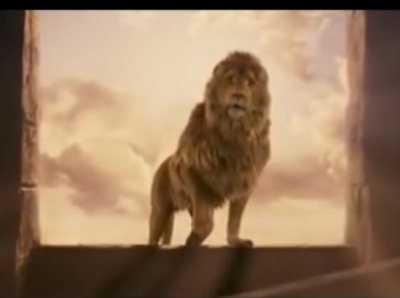
Aslan, a type of the Christ, resurrected (The Lion the Witch and the Wardrobe, 2005)
Just as Aslan, a symbol of Christ, had the final word over death; likewise the Lord Jesus will have the final word on Marriage.
On June 26, 2015, five justices of the supreme court took it upon themselves to overturn legally enacted state constitutional amendments against same sex marriage that had been enacted in 30 states[1], to redefine the meaning of marriage that has been understood as between a single man and a single woman for multiple millennia by the majority of religious adherents[2] and thereby disregard the religious beliefs of 2/3 of the world, so that the less than 4% of Americans[3] who identify as gay can legally fulfill their sinful desires. That is to say nothing of the trampling underfoot of the clear teaching of scripture[4], and the disregard for the maintenance of a modicum of morality (having already lost most of it to the sexual revelation) preferring instead to push us over the slippery slope toward polygamy, and a host of other evils.[5]
As one might expect, supporters of the gay-rights movement erupted in all sorts of displays of joy and approval. A new hashtag was born to link like minds: #lovewins. For those not on twitter, you can see a sample of the rejoicing here. I couldn’t help but be reminded of the scene from the 2005 production of CS Lewis’ The Chronicles of Narnia, The Lion, The Witch and the Wardrobe. Aslan has surrendered himself to the witch. The witch gloats in her apparent victory:
Behold, the great lion.
Bind him.
Wait, let him first be shaved.
Bring him to me.
You know Aslan, I’m a little disappointed in you.
Did you honestly think by all this that you could save the human traitor?
You are giving me your life and saving no one. Ha!
So much for love.(To the crowd) Tonight – the deep magic will be appeased. (Crowd is increasingly roused)
But tomorrow we will take Narnia forever! (round of cheering)
In that knowledge – despair and die! (thrusts a knife into Aslan)
The great cat is dead! (Cheers)
General, prepare you troops for battle. (General celebration continues)
(To herself) However short it may be.
As usual, Lewis’ allegories are uncannily accurate. Though I see at least eight parallels, so as not to be tedious, let me point out just three:
AD Apologetics – Part 2: Jesus’ Triumphant Resurrection
| The series “AD – The Bible Continues” presents a strong case for the resurrection of Jesus. |
In part 1, Jesus’ death and the empty Tomb, the uniqueness of Christianity was examined through a consideration of the following questions:
Why believe in Christianity?
What makes Christianity different from any other religion?
Why not believe in other religions?
What makes Jesus different from the founder of other religions?
How do you know Christianity is true?
Why should I believe in Jesus?
The answer to all those questions is resurrection of Jesus Christ from the dead – it is the answer to each question, and what makes Christianity unique. Furthermore, Christianity is the only religion which provides hope for us mortal men and women through a savior who has demonstrated mastery over death by himself rising from the dead. And that savior offers the same resurrection to all who believe in him.
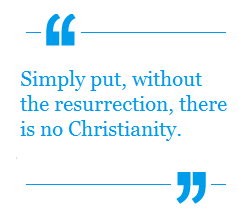
That claim – resurrection from the dead – is so startling, so bold, so beyond common experience that some people refuse to even consider it as a possibility. Such doubt has been expressed by the well known liberal scholar, the late Rudolph Bultmann who in his disbelief writes,


_550.jpg)

